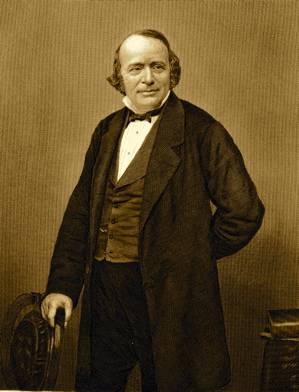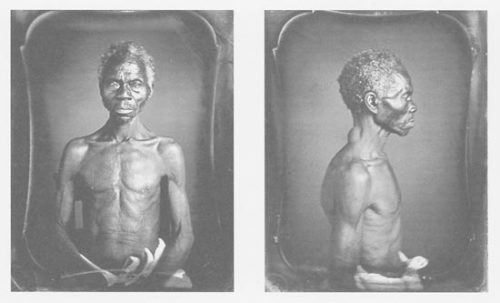
Black Bodies, White Science: Louis Agassiz's Slave Daguerreotypes
In March 1850, Louis Agassiz, celebrated Harvard natural scientist and widely admired Cambridge intellectual, arranged through the good offices of Dr. Robert W. Gibbes for a local daguerreotypist in Columbia, South Carolina, J.T. Zealy, to take a series of pictures of African-born slaves at nearby plantations. Zealy made the pictures in his studio, turned them over to Gibbes, who shipped them to Agassiz at Harvard, where in 1976, at the Peabody Museum of Archaeology and Ethnology, they were found in storage cabinet.

Louis Agassiz
… Agassiz had visited several plantations in 1850 while in South Carolina to address a meeting of scientists in Charleston on the topic of the “separate creation” of the human races. That notion, which denied the unity of mankind, seemed to provide a scientific or natural basis for racial inequality and slavery. After the meeting, at which the Harvard scientist thrilled his Southern audience by endorsing the doctrine that mankind had no common origin, Agassiz expressed interest in examining African-born slaves.

… He wanted firsthand evidence of anatomical uniqueness and also to see if these distinct traits would survive in American-born offspring. “Agassiz was delighted,” wrote Gibbes, “with his examinations of Ebo, Foulah, Gullah, Guinea, Coromantee, Mandingo, and Congo Negroes,” satisfying himself that “they have differences from other races.” He asked Gibbes to arrange for the photographs, and took his leave.

“Jack (driver), Guinea, Plantation of B.F. Taylor, Esq., Columbia, S.C.”
… The Zealy daguerreotypes reflect the unusual circumstances of Agassiz’s request. They show a conventional studio setup with a patterned carpet and the headrest stand usually hidden behind the sitter’s back. The daguerreotypes themselves feature the gold-plated overmat and wooden case typical of the commercial artifact.

However, the persons portrayed here are standing naked: not “representative” in [Mathew] Brady’s sense of an imagined and desired America, but examples of specimens of a “type” — a type, moreover, of complete otherness. It is difficult to view these images now without a sense of outrage at the indecency of the poses and the system of bondage they reflect — the absolute power of masters over the bodies of their slaves. The response is heightened by the extraordinary fact of male nudity, of genitals presented directly to that daguerrean eye in what must have been a genteel Columbia, S.C., daguerrean gallery or “parlor,” of women asked to disrobe not for prurient purposes but for “science.”

“Delia, born in the USA of enslaved
African parents, daughter of Renty, Congo“
… Without a public mask to mediate their encounter with the lens, the eyes of the enslaved Africans can only reveal the depths of their being — for, as naked slaves, they are permitted no social persona. In the absence of the clues which define Brady’s portraits as formal, heroic, at once individual and illustrious, and yet in the presence of certain conventional signs — the carpet, the stand, the case and framing mat — we confront a disturbing contradiction. The illustrations are trapped within a system of representation as firmly as the sitters are trapped within a system of chattel slavery. And they powerfully inform us of our own entrapment. We know how to view conventional portraits — but to gaze upon naked bodies, male and female, of persons dispossessed of themselves, is another matter.
The Zealy pictures reveal the social convention which ranks blacks as inferior beings, which violates civilized decorum, which strips men and women of the right to cover their genitalia. And yet the pictures shatter that mold by allowing the eyes of Delia and the others to speak directly to ours, in an appeal to a shared humanity.

His name is Renty, he was born in the Congo, and enslaved on the plantation of B.F. Taylor, in Columbia, South Carolina
… By allowing their subjects to gaze through the lens directly at us, the Zealy portraits immobilize the physiognomic theory which supports [Marcus Aurelius] Root’s confidence. Stripped of everything deemed intrinsic to selfhood and “character,” if not humanness itself, they are simply themselves — what we see. The photographer takes no pains to “portray” them or to elicit an expression.

Agassiz commissioned these images to use as scientific visual evidence to prove the physical difference between white Europeans and black Africans. The primary goal was to prove the racial superiority of the white race. The photographs were also meant to serve as evidence for his theory of “separate creation,” which contends that each race originated as a separate species.
By obeying his commission to present them as bodies rather than persons, as biological specimens, Zealy allows them to be as they are: black slaves constrained to perform the role of specimen before the camera. The absoluteness of their confinement to this role has the unintended effect of freeing their eyes from any other necessity but to look back at the glass eye staring at them. Their gaze defies the scrutinizing gaze aimed at their nakedness, and challenges the viewer of these daguerreotypes to reckon with his or her responses to such images.

Portrait of Louis Agassiz. In this photo he is seen demonstrating his theory of jelly-fish, corals and starfish. So where did it all go wrong for this workaholic who once declared he could not afford to waste his time making money and was ready to sacrifice everything to science? Two words sum it up: Darwin and racism. He was considered the most important scientific opponent of Darwinism, refusing to admit the evolutionary theory of the English naturalist.
Louis Agassiz's Public racism

Swiss scientist Louis Agassiz was one of the most influential researchers of the 19th century, promoting the Ice Age and boosting science in the United States.
Yet 200 years after his birth his legacy is almost invisible, tainted by his opposition to Darwinism and his publicly stated racism.
Agassiz's racism proved more problematic and is probably what has seen him vanish as a public face of American science. After arriving in the US, he felt confronted by black people and wrote to his mother that he felt physically ill in their presence.

Published at the height of polygenism's popularity, Josiah Nott and George Gliddon's 800-page illustrated volume, Types of Mankind, reproduced the work of Louis Agassiz and Samuel Morton, spreading racist views to a popular audience. The work sold well and nine editions were printed. Some slave owners found justification for slavery in the Bible, and others used this new "science" to defend it.
He certainly believed in the separation of the races and his own theory was blacks and whites had different origins.
While it was not an unusual position at the time, his influence meant that his words had a major impact on the debate about racial equality and slavery.
"His behaviour stank," Kaeser told swissinfo. "His use of the media was hypocritical and his mixing of science and politics was unethical."
This probably goes a long way to explaining why Agassiz lies almost forgotten in Mount Auburn cemetery in Cambridge, Massachusetts, while the tercentenary of the birth of Swiss mathematician Leonhard Euler is being celebrated around the world. (source: swissinfo, Scott Capper)

Agassiz is not totally forgotten. My daughter wrote a term paper on him recently, which was a study of his life and work, esp. polygenism.
ReplyDeleteThat's not a term paper, that's a doctoral thesis.
DeleteI'm curious, did she travel to Harvard to read any of his papers or did she conduct her research using secondary sources?
Ron, you're a snitch.
DeleteForgotten? There are two, at least, mountains in California alone named after him. If you've ever hiked the Palisades, you've heard of Louis Agassiz...
ReplyDeleteSome people had problems with their eyes, blurred vision especially when they get older. Thus a robust eye doctors willing to provide solutions to our problems.
ReplyDeleteeye doctor columbia sc
These are the criminals who break into computer systems that they are visiting?
ReplyDeleteNo secrets will remain hidden away from you by installing a keylogger for
Mac can secretly send the logs by email or FTP
to a specified receiver for examination. Online you can find
many anti key loggers that may efficiently eliminate the effect of every malware
installed on the actual computer it has been greatly improved in its invisible work.
My web-site: keylogger free
There was one unintended good result of these pictures: We know the names of these slaves--Jack, Delia and Renty--what they looked like, and where they live. Most other slaves of that time are lost to oblivion.
ReplyDeleteThose were their slave names.
DeleteYes. That is a wonderful result of these Daguerreotypes. They give actual faces to slavery and the faces are very human. The idea was to make this race of people, whom God created by his own hand, appear less than human, but the meekness and humility by which they sit, captured, in these photographs proves their humanity in a much grander sense than the humanity of the monsters who attempted to dehumanize them. Their eyes reveal a tortured and misused existence. Their posture reveals their utter submission in the face of forced nudity. Yet, these photgraphs are stunning.
DeleteAs some of this text is copied verbatim, you should probably cite the original source - Alan Trachtenberg, “Illustrious Americans,” in Reading American Photographs: Images as History, Mathew Brady to Walker Evans. New York: Hill and Wang, 1989.
ReplyDeleteYou're right! I'll fix it.
DeleteMore of these pictures can be found here:
ReplyDeletehttp://nationalhumanitiescenter.org/pds/maai/enslavement/text1/photosenslaved.pdf
For an in-depth article go here:
ReplyDeletehttp://www.studythepast.com/4333_spring12/materials/black_bodies_white_science.pdf
There was a recent biography of Agassiz also by Christoph Irmscher.
ReplyDeleteI once had a dag done by Zealy which portrayed,according to a note behind the plate,"Miss Zealy and Miss Taylor." Im assuming one was Zealy's daughter the other B.F.Taylor's.Taylor of course 'owned' the slaves photographed by Zealy at Agassiz's behest.
ReplyDeleteIt's now in the Southcaroliniana Library in Columbia S.C.
fuck his work. He's a piece of shit racist scum
ReplyDeleteThis comment has been removed by the author.
ReplyDeleteThis comment has been removed by the author.
ReplyDeleteCarpet Bright UK uses effective cleaning methods to remove anything that makes your carpet look unsightly. Our team of cleaning specialists will make sure your carpet is free from dirt, dust, moulds and animal dander after each service Carpet Cleaners Canary Wharf. Address: 61 Willow Walk, London, SE1 5SF.. => Phone: 020 3011 5506
ReplyDeleteThis comment has been removed by the author.
ReplyDeleteThis comment has been removed by the author.
ReplyDeleteThis is a really good blog post! Website Design / Google PPC Management
ReplyDeleteyou could try this out Goyard Dolabuy Check This Out Louis Vuitton replica Bags article source replica bags from china
ReplyDeleteGreat Article. Thank you for sharing! Really an awesome post for every one.
ReplyDeleteLight Base For Crystal
Hey y'all I can slightly agree with Mr Sanity Inspector. I'm from the South born and raised, it's in my DNa, West Africa that is...At the end of the day let a Southern H.B.C.U. have those photos of those enslaved Africans. God have mercy on us All, myself included. God bless Sengbe Bieh, and some others, GOD BLESS or may God be praised. At least Mr. Sengbe did the right thing at the end of day, (or long time ago). Abarika Uncle Sengbe, no "Uncle Tom's included". Or should I say I need a passport for myself. Thank you God and Sengbe Bieh, no Cinque, Bieh is the real name, family name.......
ReplyDeleteI appreciate you finding the time and effort to put this article together. I 카지노사이트가이드
ReplyDelete토토사이트
. But so what, it was still worth it! Feel free to visit my website; 카지노사이트가이드
ReplyDelete토토사이트
Our CMS Development Agency Dubai uses a ground up approach to develop content management systems that simplify editing and have tailored, easy-to-use interfaces.
ReplyDelete